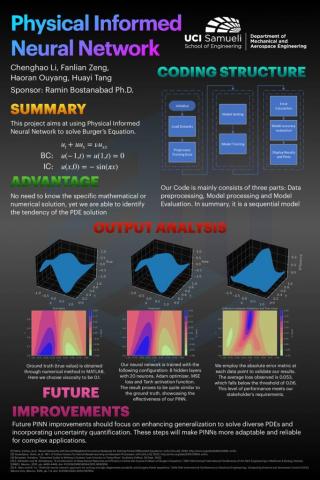Physical Informed Neural Network (PINN)
Background Introduction
Physics-Informed Neural Networks (PINNs) represent a cutting-edge approach to solving partial differential equations (PDEs) by leveraging the power of deep learning. These networks integrate known physical laws into the structure of the neural network, ensuring that the solutions they generate are not only data-driven but also conform to the underlying physical principles. This methodology is particularly beneficial for solving complex PDEs that arise in various fields of science and engineering.
- Physics-Informed Neural Networks (PINNs)
PINNs incorporate the physics of the problem, usually in the form of PDEs, directly into the loss function of the neural network. This means the network is trained not only to fit the available data but also to obey the physical laws represented by the PDEs. This dual approach helps in generating more accurate and physically plausible predictions, especially in scenarios where data is sparse or expensive to obtain.
- Navier-Stokes Equations & Burger's Equations
The Navier-Stokes equations describe the motion of viscous fluid substances and are a set of nonlinear PDEs. They are fundamental in fluid mechanics and are used to model the flow of fluids in various applications, from aerodynamics and oceanography to blood flow and weather forecasting. The equations express conservation of momentum, mass, and energy within a fluid.
Burger's equation is a fundamental PDE that appears in various areas of applied mathematics, including fluid mechanics, nonlinear acoustics, gas dynamics, and traffic flow. It is a simpler form of the Navier-Stokes equations and is used to describe processes involving shock waves and turbulence. The equation combines nonlinear convection and diffusion processes and is given by:
(u_t) + u * (u_x) = ν * (u_xx)
where u is the velocity field, t is time, x is the spatial coordinate, and ν is the kinematic viscosity.
- Possible Application
Fluid Dynamics: In areas such as aerodynamics and hydrodynamics, PINNs can help model and simulate fluid flow around objects, which is crucial for designing vehicles, aircraft, and marine vessels with optimal performance and fuel efficiency.
Weather Prediction: By solving simplified versions of the Navier-Stokes equations, PINNs can contribute to more accurate weather forecasting models, especially in predicting complex phenomena like storms and hurricanes.
Environmental Engineering: PINNs can model the dispersion of pollutants in air and water, aiding in the assessment of environmental impacts and the design of pollution mitigation strategies.
Biomedical Engineering: In the modeling of blood flow through arteries and veins, PINNs can help predict the development of conditions like atherosclerosis or the performance of artificial heart valves.
Innovation
Physics-Informed Neural Networks (PINNs) are designed to solve problems governed by differential equations, integrating physical laws into the training process. They utilize the structure of traditional neural networks, but with a key modification: the loss function is augmented to include terms that enforce the compliance of the network's predictions with the underlying physical principles. This is achieved by incorporating the differential equations governing the physical system directly into the loss function, alongside any available data. This approach allows PINNs to leverage both observed data and the known physics of the problem, enabling them to predict outcomes with high accuracy even in scenarios where data are sparse or noisy.
Goals and Objectives
The project aims to design an effective partial differential equation (PDE) solver using neural networks to solve fluid mechanics problems, with a focus on Burger’s Equation. It involves generating random data and fitting a physics-informed neural network. The project will utilize Python for implementation, emphasizing clear code annotation, handling data noise, and flexibility for solving various PDEs. It should be ensured that model predictions closely match analytical solutions with a target loss of less than 0.06. The design will also adhere to Design of Experiment (DoE) rules. Our ultimate aim is to ensure the solver has adaptability and robustness in handling complex fluid dynamics equations.
Link to Our Code
https://colab.research.google.com/drive/1_XhMydgoDHCNCts65vvf_x3P6ueRjTDp?usp=sharing
Team Contacts
Chenghao Li email: cli58@uci.edu
Huayi Tang email: huayit1@uci.edu
Haoran Ouyang email: houyang1@uci.edu
Fanlian Zeng email: fanlianz@uci.edu
Sponsor
Ramin Bostanabad email: raminb@uci.edu
Advisor
Mark Walter email: m.walter@uci.edu


